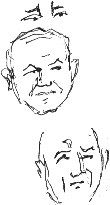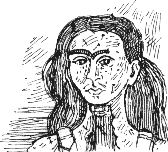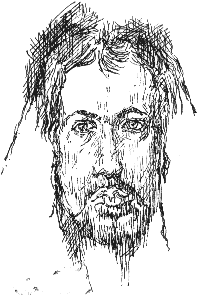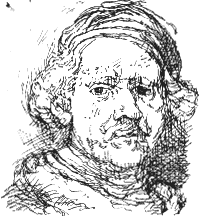|
|
 Okay,
these don't look much like the real Rick Stein,
currently sailing along the Canal du Midi in his television series
French Odyssey, but the nature of his programme is that
we get a brief look at Stein and the chef, fisherman, farmer or
wine-maker he's interviewing, then plenty of leisurely footage of
beautiful French countryside and perfect little market towns punctuated
by lots of robustly delicious food. Okay,
these don't look much like the real Rick Stein,
currently sailing along the Canal du Midi in his television series
French Odyssey, but the nature of his programme is that
we get a brief look at Stein and the chef, fisherman, farmer or
wine-maker he's interviewing, then plenty of leisurely footage of
beautiful French countryside and perfect little market towns punctuated
by lots of robustly delicious food.
My brother Bill and his wife Michelle recently bought a house in
the Vendee, where Stein's journey begins.
. . . and am I jealous? Moi?!
In order to add a recognisable drawing of Stein to these snippets,
I turn to the Radio Times, where as luck would have it,
there's a whole page on French Odyssey including a large
photograph of . . . Cherry Pithiviers; no, she's
not the owner of a canal-side patiserrie, this is a sumptuous cherry
tart with a puff pastry topping, made using Quercy region cherries.
Quercy? Isn't that a kind of keyboard? |
Drawn into her World
  Turning
back a page from the cherry pie, there's an article on Matthew
Collings’ Channel 4 series Self-Portraits: The Me Generation. Turning
back a page from the cherry pie, there's an article on Matthew
Collings’ Channel 4 series Self-Portraits: The Me Generation.
I have difficulty drawing from Freda Kahlo's self-portrait
(one of 150 she painted), Broken Column (1944), so, resorting
to the advice given by Betty Edwards in Drawing on
the Right Side of the Brain, I turn the page upside down and try
again (right).
It's not just a case of drawing her appearance; I also find myself drawn
into her disturbing world of Mexican folklore, votive images and self-laceration.
This shouldn't make drawing what I see on the page any more difficult,
but, so it seems to me, it does. She isn't a comfortable presence!
Star Quality
  Drawing
Albrecht Dürer's Self-Portrait in Fur Coat
(1500) reminded me of Mick Fleetwood and other rock stars
of his generation. According to Collings, in the first programme of the
Self-Portrait series, this is no accident: artists with a capital
'A' were something new in 16th century Germany - until then they were
thought of as craftsmen, just like the masons and carpenters they worked
alongside. Collings suggests that another Dürer portrait, showing
the artist ostentiously posing in the latest Italian fashions (the kind
of thing Fleetwood and co. wore on their album covers), is an attempt
to win for artists some social cachet. Drawing
Albrecht Dürer's Self-Portrait in Fur Coat
(1500) reminded me of Mick Fleetwood and other rock stars
of his generation. According to Collings, in the first programme of the
Self-Portrait series, this is no accident: artists with a capital
'A' were something new in 16th century Germany - until then they were
thought of as craftsmen, just like the masons and carpenters they worked
alongside. Collings suggests that another Dürer portrait, showing
the artist ostentiously posing in the latest Italian fashions (the kind
of thing Fleetwood and co. wore on their album covers), is an attempt
to win for artists some social cachet.
The messianic role of the artist suggested in his Fur Coat portrait
also has its parallels in the world of rock.
Rembrandt
As you'd probably guess, I'd feel happier spending a day drawing old
Amsterdam (or anywhere else, for that matter) with Rembrandt
(right, Self-Portrait, 1665). Dürer and Kahlo come across
as scary, driven, awesomely talented characters both in their appearance
and in the way they paint; Rembrandt seems more down to earth but he also
seems to be the one who is most likely to have stumbled on the secret
of the meaning of life, a kind of Gandalf or Professor Dumbledore for
his time.
 And
it's not just me who sees it that way: And
it's not just me who sees it that way:
'When scientists could use a mathematical idea to transform matter they
had achieved the same quasi-magical relationship with the material world
as artists.' writes Kenneth Clark , concluding Civilisation,
his survey of western art, ' Look at Karsh's photograph of Einstein
(left). Where have we seen that face before? The aged Rembrandt.'

Link
Rick Stein
Richard Bell, richard@willowisland.co.uk
|